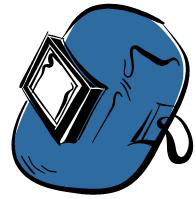|
|

|
Steel Weld Design:
|
|
This design guide is intended to provide guidance for the safe and economical design
of steel welds and welded steel connections. This design guide and the corresponding
calculations are based on the 14th edition of the AISC Steel Construction Manual.
All calculations can be performed for Load Resistance Factor Design, LRFD or Allowable
Strength Design, ASD.
|
Steel Weld Design Using The 14th Edition AISC Steel Construction Manual:
|
|
|
Design of Welded Steel Connections:
|
|
The design of welded steel connections is a simple process left to the descretion
of the engineer. The design process can be broken down into consideration
of the type of load.
|
Type of Loading:There are two types of loading
that a welded connection should be designed for: concentric loading and eccentric
loading. Concentric loading is the case where the connection will only have
to resist the effects of direct shear and/or direct tension alone and the load is
along the line of the centroid of the weld group. (Note: in the nonconcentric
case where the load does not pass thru the center of the weld group it is desirable
to re-design the weld group to a balanced condition where the load passes thru the
center of the weld group, the concentric case.) Eccentric loading is where
the connection will have to resist the effects of moment load as well as the direct
shear and/or tension. Eccentric loading is broken down to analyze the loads
derived by the moment into additional shear or tension loads placed on the welds.
Unlike bolted connections welds can simultaneously carry tension and shear stresses
and the strength requirement of the weld is equal to the vectoral summation of the
tension and shear forces.
|
|
In summary the design of welded connections varies by the unique loading of each
connection and each situation that the designer sees.
|
|
The following calculations come from Chapter 8 and Section J.2 of the AISC Steel
Construction Manual, and are used for the design of welded steel connections and
the determination of weld strength:
|
|
|
|
|
|
The following are some useful tables to be used in the design of welded connections:
|
|
|
Coefficients, C, for Concentrically Loaded Weld Group Elements:
Load angle
on weld element,
degrees
|
Largest load angle on and weld group element, degrees
|
|
90
|
75
|
60
|
45
|
30
|
15
|
0
|
|
0
|
0.0825
|
0.849
|
0.876
|
0.909
|
0.948
|
0.994
|
1.00
|
|
15
|
1.02
|
1.04
|
1.05
|
1.07
|
1.06
|
0.883
|
|
|
30
|
1.16
|
1.17
|
1.18
|
1.17
|
1.10
|
|
|
|
45
|
1.29
|
1.30
|
1.29
|
1.26
|
|
|
|
|
60
|
1.40
|
1.40
|
1.39
|
|
|
|
|
|
75
|
1.48
|
1.47
|
|
|
|
|
|
|
90
|
1.50
|
|
|
|
|
|
|
|
|
|
Minimum Size of Fillet Welds:
Material Thickness of Thinner
Part Joined, in. (mm)
|
Minimum Size of Fillet
Weld, Leg or D, in. (mm)
|
|
To 1/4 (6) inclusive
|
1/8 (3)
|
|
Over 1/4 (6) to 1/2 (13)
|
3/16 (5)
|
|
Over 1/2 (13) to 3/4 (19)
|
1/4 (6)
|
|
Over 3/4 (19)
|
5/16 (8)
|
|
|
|
Minimum Effective Throat Thickness of Partial-Joint-Penetration Groove Welds:
Material Thickness of Thinner
Part Joined, in. (mm)
|
Minimum Effective
Throat Thickness, in. (mm)
|
|
To 1/4 (6) inclusive
|
1/8 (3)
|
|
Over 1/4 (6) to 1/2 (13)
|
3/16 (5)
|
|
Over 1/2 (13) to 3/4 (19)
|
1/4 (6)
|
|
Over 3/4 (19) to 1 1/2 (38)
|
5/16 (8)
|
|
Over 1 1/2 (38) to 2 1/4 (57)
|
3/8 (10)
|
|
Over 2 1/4 (57) to 6 (150)
|
1/2 (13)
|
|
Over 6 (150)
|
5/8 (16)
|
|
|
|
Properties of Weld Groups:
Weld Group Properties |